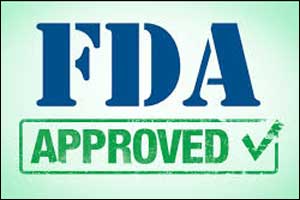- Home
- Editorial
- News
- Practice Guidelines
- Anesthesiology Guidelines
- Cancer Guidelines
- Cardiac Sciences Guidelines
- Critical Care Guidelines
- Dentistry Guidelines
- Dermatology Guidelines
- Diabetes and Endo Guidelines
- Diagnostics Guidelines
- ENT Guidelines
- Featured Practice Guidelines
- Gastroenterology Guidelines
- Geriatrics Guidelines
- Medicine Guidelines
- Nephrology Guidelines
- Neurosciences Guidelines
- Obs and Gynae Guidelines
- Ophthalmology Guidelines
- Orthopaedics Guidelines
- Paediatrics Guidelines
- Psychiatry Guidelines
- Pulmonology Guidelines
- Radiology Guidelines
- Surgery Guidelines
- Urology Guidelines
FDA approves new drug for Open-Angle Glaucoma or Ocular Hypertension

The Food and Drug Administration (FDA) has approved new drug Rocklatan (netarsudil 0.02% and latanoprost 0.005% ophthalmic solution; Aerie) for the reduction of elevated intraocular pressure (IOP) in patients with open-angle glaucoma or ocular hypertension.
Rocklatan ™ is a once-daily eye drop that is a fixed-dose combination of latanoprost, the most widely-prescribed prostaglandin analog (PGA), and netarsudil, the active ingredient in Rhopressa® (netarsudil ophthalmic solution) 0.02%, a first-in-class Rho kinase (ROCK) inhibitor specifically designed to target the trabecular meshwork (the eye’s principal drainage pathway). The diseased trabecular meshwork is considered to be the main cause of elevated IOP in open-angle glaucoma and ocular hypertension. Rhopressa® works by restoring outflow through the trabecular meshwork, while latanoprost increases fluid outflow through a secondary mechanism known as the uveoscleral pathway.
Aerie launched Rhopressa® in the United States in April 2018. The Company plans to launch Rocklatan ™ in the United States in the second quarter of 019.
“We are in the unique position of receiving FDA approval on a second glaucoma treatment less than a year from the U.S. launch of Rhopressa®,” saidVicente Anido, Jr., Ph.D., chairman and chief executive officer at Aerie. “Together, Rocklatan ™ and Rhopressa® give us a broad therapeutic franchise,
based on our ROCK inhibitor netarsudil, that addresses many of the needs of clinicians and patients in a wide variety of treatment settings. Our existing salesforce, which has been calling on U.S. eye-care professionals since last May, is very well positioned to introduce Rocklatan ™ to these doctors and help them understand the clinical utility of both products in the care of their patients with glaucoma. We have also been working diligently on securing favorable reimbursement for our products, with Rhopressa® now enjoying broad commercial and Medicare Part D coverage, and Rocklatan ™ already under review by major payers.”
The FDA approval of Rocklatan ™ is based on data from two Phase 3 registration trials, MERCURY 1 and MERCURY 2. In these studies, Rocklatan
achieved its primary 90-day efficacy endpoint as well as positive 12-month safety and efficacy results, demonstrating statistically superior IOP
reduction over latanoprost and netarsudil at every measured time point. More than 60% of patients taking Rocklatan ™ in the two MERCURY studies
achieved an IOP reduction of 30% or more, a frequency that was nearly twice that achieved by participants taking latanoprost alone. Rocklatan ™ also
helped more patients get to low target pressures. Nearly twice as many patients taking Rocklatan ™ reached 16 mmHg or lower and nearly three times as many reached 14 mmHg or lower compared to latanoprost.
In the two MERCURY studies, Rocklatan ™ treatment was associated with generally mild and tolerable ocular adverse events, with minimal systemic
side effects. The most common ocular adverse event in controlled clinical studies with Rocklatan™ was conjunctival hyperemia. Ninety percent of patients who experienced hyperemia reported it as mild and 5% discontinued because of it. Other common ocular adverse effects reported in the studies include instillation site pain, corneal verticillata and conjunctival hemorrhage.
About Rocklatan ™
Indications and Usage
ROCKLATAN™ (netarsudil and latanoprost ophthalmic solution) 0.02%/0.005% is indicated for the reduction of elevated intraocular pressure (IOP) in patients with open-angle glaucoma or ocular hypertension.
Select Important Safety Information
Although not observed in the two MERCURY studies, latanoprost has been reported to cause changes to pigmented tissues, including pigmentation of
the iris, periorbital tissue (eyelid) and eyelashes. Iris pigmentation is likely to be permanent. Latanoprost has also been associated with gradual changes to eyelashes including increased length, thickness and number of lashes. These changes are usually reversable.
Rocklatan 0.02%/0.005% ophthalmic solution will be supplied as a 2.5mL fill in a 4mL container. It is expected to be available in the second quarter of 2019

Disclaimer: This site is primarily intended for healthcare professionals. Any content/information on this website does not replace the advice of medical and/or health professionals and should not be construed as medical/diagnostic advice/endorsement or prescription. Use of this site is subject to our terms of use, privacy policy, advertisement policy. © 2020 Minerva Medical Treatment Pvt Ltd